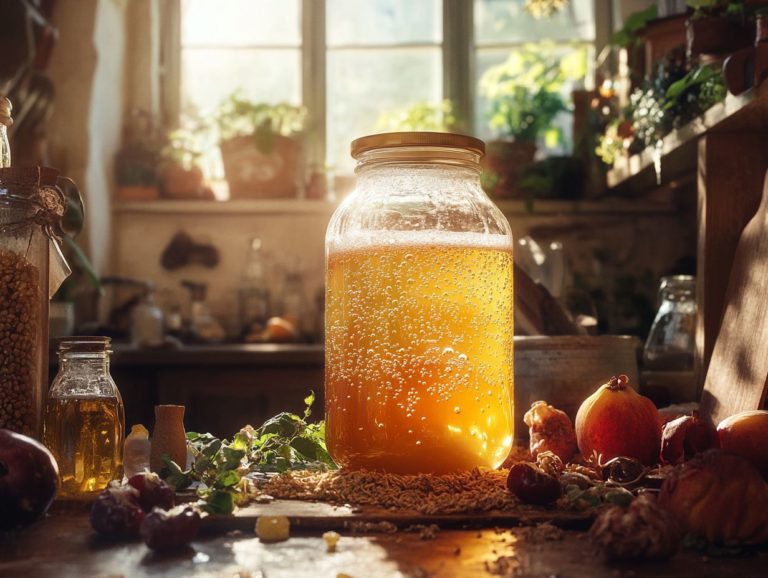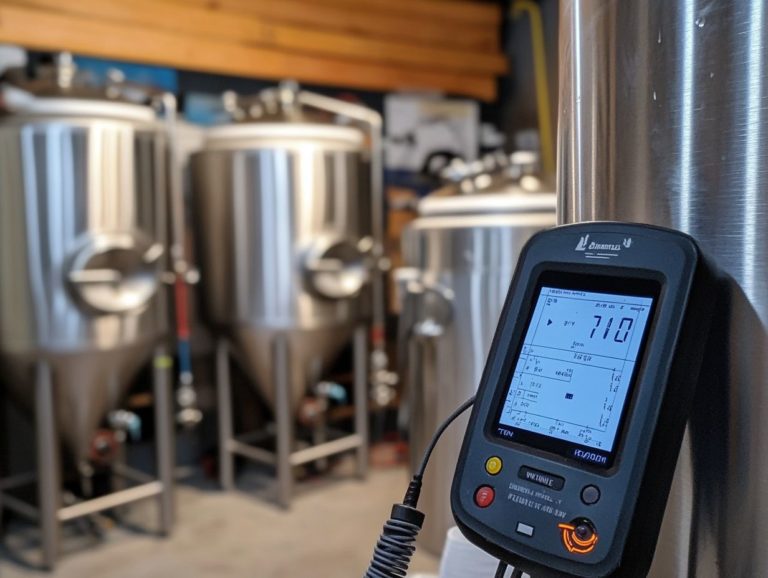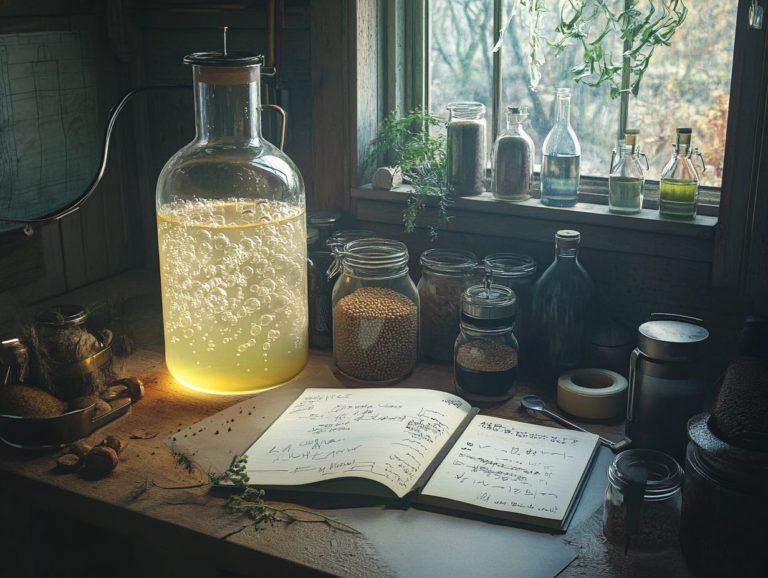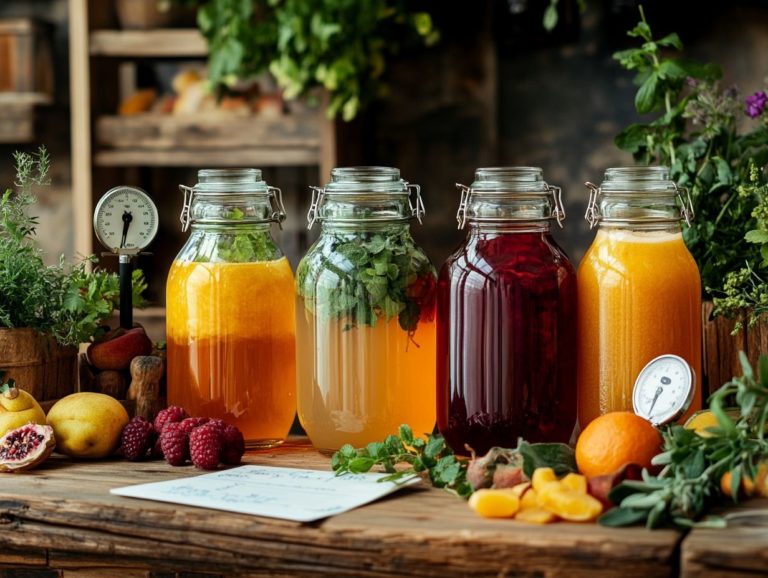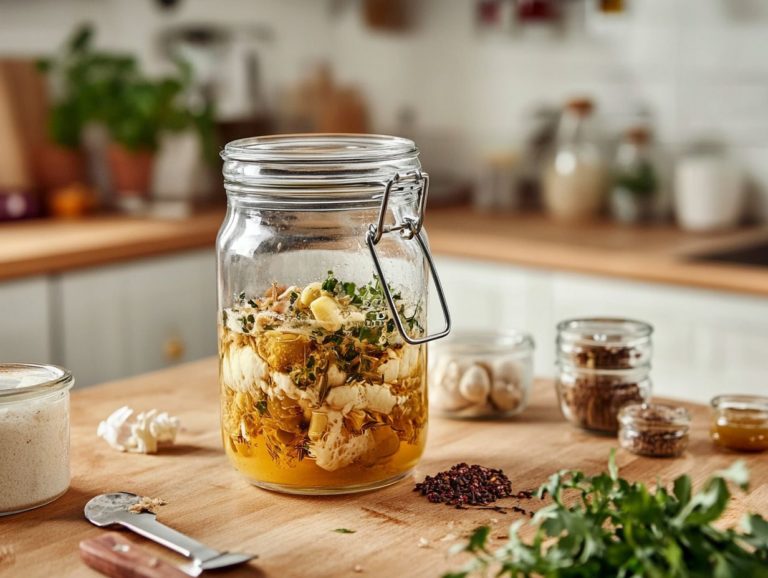Troubleshooting Fermentation: Common Problems
Fermentation is an art that turns simple ingredients into exquisite foods and beverages like sauerkraut, kimchi, and kombucha. However, the journey can sometimes take unexpected turns.
You may encounter challenges such as mold growth, white film like Kahm yeast, and unwelcome odors such as sulfur or vinegar smell that can disrupt your fermentation process. It’s essential to recognize the telltale signs of trouble, including slimy textures and off-putting flavors, along with practical troubleshooting techniques to address these issues.
Whether you’re a seasoned fermenter or embarking on your culinary adventure for the first time, this guide will empower you to navigate the complexities of fermentation. You will learn how to maintain safe fermentation practices to avoid botulism risk with confidence and finesse.
Contents
- Key Takeaways:
- 1. Mold Growth
- 2. No Signs of Fermentation
- 3. Unpleasant Odor
- 4. Slimy Texture
- 5. Off-putting Taste
- 6. Cloudy or Discolored Liquid
- 7. Gas Buildup
- 8. Fermentation Stops Prematurely
- 9. Fermentation Takes Too Long
- 10. Fermentation Is Too Fast
- How to Troubleshoot Common Fermentation Problems?
- Frequently Asked Questions
- What are some common problems that may occur during fermentation?
- What is stuck fermentation and how can it be resolved?
- How can off-flavors be detected and prevented during fermentation?
- What are the signs of contamination during fermentation?
- How can contamination be avoided during fermentation?
- What should I do if my fermentation does not start?
Key Takeaways:
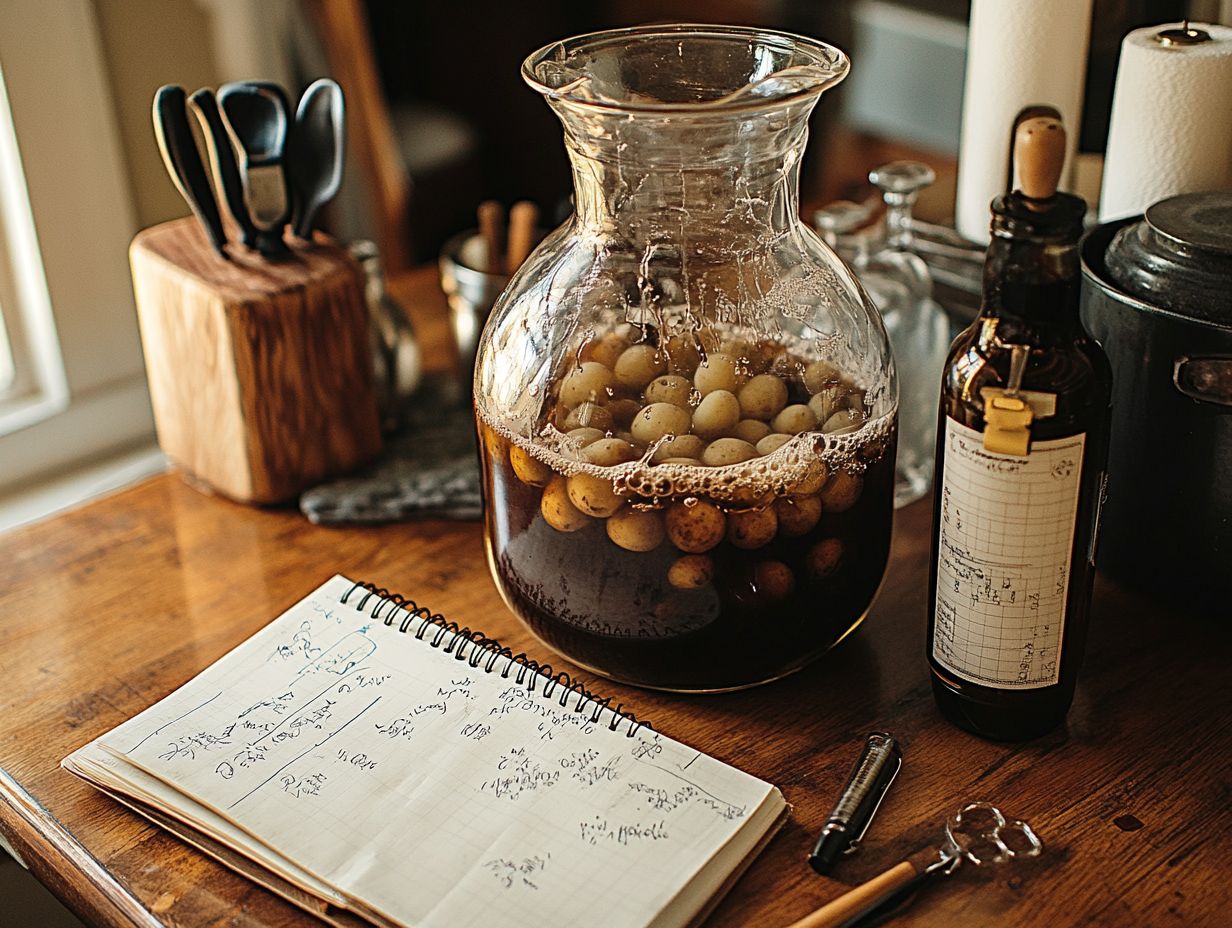
- Unlock the secrets to successful fermentation! Mold growth can be prevented by maintaining a clean environment.
- No signs of fermentation might indicate low temperature or insufficient starter culture.
- Fresh ingredients and sanitation methods are key to avoiding unpleasant odors.
1. Mold Growth
Mold growth is a common challenge during the lacto-fermentation process. This is especially true for those eager to ferment vegetables like garlic, onions, and Brussels sprouts.
It s essential to practice safe fermentation techniques to avoid health risks associated with harmful bacteria, including E. coli and botulism. Monitoring the fermentation temperature and cleaning the jars are crucial steps.
Several factors contribute to this pesky issue, with environmental conditions and improper fermentation temperatures at the forefront. Achieving ideal temperatures is critical; too warm or too cold can foster an environment ripe for unwanted microbial activity, including mold. It’s also important to recognize that while Kahm yeast a white film that might show up during fermentation isn’t necessarily harmful, its presence can signal that fermentation isn t proceeding as it should. This could be due to fluctuating conditions or brine disappearance.
To mitigate these risks, ensure your fermentation jars are impeccably clean, use proper weights to keep your vegetables submerged, and maintain consistent temperatures in a shaded area, ideally between 68 F and 72 F, for the best results. By doing so, you ll set yourself up for a successful fermentation experience.
2. No Signs of Fermentation
When you re fermenting vegetables, it can be quite disheartening to see no signs of fermentation no bubbling, gas buildup, or other fermentation signs. This usually means those essential microorganisms are just not getting into the action.
This lack of activity often hints that your fermentation environment isn t quite right. Pay attention to visual cues like bubbles or froth; these are great indicators that carbon dioxide is being produced by actively working bacteria. If you catch a whiff of lactic acid, that sour scent confirms that beneficial microbes are hard at work. But if these signs are absent, it could be due to factors like an incorrect salt concentration or an unsuitable temperature.
Make sure your salt level hovers around 2-3% of sodium chloride, and keep that fermentation vessel cozy in a warm, dark spot. This will help create the perfect conditions for a successful fermentation journey, ensuring that the lacto-fermentation process runs smoothly.
3. Unpleasant Odor
An unpleasant odor from your fermentation jars is a warning sign. Distinct smells like sulfur or putrefaction indicate fermentation problems. These issues may jeopardize the safety of your fermented foods.
These odors often arise from unwanted bacteria that outcompete the beneficial microorganisms essential for successful fermentation. For example, a strong sulfur smell might suggest the presence of bacteria that thrive in low-oxygen environments, which are typically associated with poorly managed fermentations. Similarly, a vinegar smell could indicate an overactive fermentation environment.
To address these concerns, it s crucial to ensure that all your equipment is meticulously sanitized. Additionally, monitor fermentation conditions including temperature and pH levels. By creating an optimal environment, you not only minimize off-putting smells but also foster the growth of good bacteria, guaranteeing that your final product is both safe and delicious.
4. Slimy Texture
A slimy texture in your fermented vegetables can be quite concerning. It signals potential fermentation issues caused by an abnormal level of microorganisms. These microorganisms could disrupt the growth of beneficial bacteria and compromise the quality of your delicious creations. Raw vegetables can sometimes contribute to this issue if not properly prepared.
Several environmental factors can contribute to this unwelcome texture. Primary culprits include overly high fermentation temperatures and improper salt concentrations. High temperatures encourage unwanted bacteria to thrive, while insufficient salt can lead to inadequate preservation, resulting in the sliminess you d rather avoid.
To accurately evaluate the texture of your fermented vegetables, assess both their appearance and how they feel when you handle them. If you encounter that slippery consistency, it might be time to lower the fermentation temperature, tweak the amount of salt in your brine, or ensure you re using clean utensils to prevent contamination. The right salt in fermentation can make a significant difference in the final vegetable texture. Don’t let slimy textures ruin your hard work! Assess how your vegetables feel and adjust the fermentation process.
5. Off-putting Taste
An off-putting taste in your fermented vegetables can dampen your culinary experience. It often indicates potential issues in the fermentation process, arising from insufficient fermentation time or imbalanced ingredients.
Taste is an essential indicator of fermentation success, reflecting the delicate balance of flavors that can be easily disrupted. For example, if fermentation goes on for too long, you might end up with an overpowering sourness that overshadows the intended flavors. If the salt concentration is inadequate, it can create imbalances that allow unwanted bacteria to thrive, ultimately spoiling the taste profile.
To avoid these pitfalls in your future batches, consider meticulously monitoring the fermentation environment and adjusting the salt content as needed. Keeping a close eye on fermentation duration can help ensure your vegetables reach their optimal flavor, steering clear of unpleasant surprises. Understanding fermentation time is essential for achieving the desired taste.
6. Cloudy or Discolored Liquid

Cloudy or discolored liquid in your fermentation jars can certainly raise some eyebrows regarding the fermentation process. This cloudy brine might indicate issues like harmful bacteria or insufficient brine concentration, which can compromise the overall quality of your beloved fermented foods.
Microorganisms are the unsung heroes of fermentation, and their activity can lead to fluctuations in liquid clarity. For example, when yeast and bacteria interact with sugars and acids, they can produce byproducts that either cloud the liquid or change its color. Sometimes, these changes are innocuous, as certain beneficial cultures create a natural haze. However, they can also be a red flag for potential spoilage or even the appearance of white particles. To combat this, it s crucial to regularly monitor pH levels and brine strength. Maintaining a clean fermentation environment and using sterilized equipment will also contribute to preserving that lovely clarity.
Moreover, considering a secondary fermentation can be a game changer. It can help clarify a muddied result while allowing the flavors to mature and enhancing the visual appeal of your creation. This step is often used in the brewing process of beverages like kombucha and water kefir.
7. Gas Buildup
Gas buildup is a natural byproduct of the fermentation process, stemming from the activity of yeast and lactic acid bacteria. This is especially common in the lacto-fermentation process. However, if you allow this gas to accumulate unchecked, it can create pressure-related issues in your fermentation jars, raising safety concerns.
This gas accumulation is not just a nuisance; it s a vital sign that your fermentation is actively underway, indicating that the yeast and bacteria are thriving and diligently performing their metabolic functions. Monitoring this gas release is essential, not only to ensure that fermentation proceeds smoothly but also to protect the integrity of your containers. Regularly checking for fermentation signs like bubbles can help you keep track of the process.
For anyone involved in fermentation, investing in equipment designed to safely manage excess gas is paramount. Tools like airlocks and fermentation jars with proper lids are invaluable, as they permit gas to escape while keeping contaminants at bay. Additionally, regularly checking the fermentation environment to maintain optimal temperature and humidity levels will further help you mitigate the risks associated with gas buildup.
8. Fermentation Stops Prematurely
When fermentation halts prematurely, it can lead to unsatisfactory results and even create an environment where harmful bacteria may flourish in your batch. This makes it essential for you to troubleshoot fermentation issues to guarantee the safety and quality of your fermented products. Effective fermentation troubleshooting can help you identify and resolve the underlying problems.
Several factors can contribute to this problem, with improper fermentation temperature being a primary culprit. Extreme heat or cold can inhibit yeast activity, while inadequate salt concentration can disrupt the delicate balance necessary for healthy fermentation. Additionally, keeping track of the fermentation time and understanding the fermentation process can prevent premature halts.
To tackle these concerns, it s crucial for you to closely monitor your environment, ensuring that the temperature remains optimal for the specific strain of yeast you re using. Adjusting the salt levels in your recipe may also breathe new life into the fermentation process.
If you encounter significant delays, consider introducing a new yeast starter or providing gentle agitation to stimulate activity. These actions can help ensure that your fermentation reaches a successful finish.
9. Fermentation Takes Too Long
If your fermentation is taking longer than expected, it can be quite frustrating. This delay may suggest issues with your methods. Factors such as incorrect temperatures or insufficient salt concentration can significantly impact the final product.
Typically, if the fermentation period stretches beyond the anticipated timeframe often extending over several weeks it could indicate problems. Contributing factors include unsuitable environmental conditions, a lack of active cultures, or the quality of your ingredients. For example, higher ambient temperatures can accelerate fermentation, while cooler temperatures can bring it to a crawl.
To optimize your fermentation process, regularly monitor the vessel for signs of activity or stagnation. Create a stable temperature environment, and maintain the right balance of salt and sugar. If problems keep popping up, take immediate action to re-evaluate your starter culture to ensure it is viable and active. Additionally, if you encounter issues with fermentation, consider checking out troubleshooting stuck fermentation issues for solutions.
10. Fermentation Is Too Fast
If fermentation is happening too quickly, it may signal uncontrolled conditions, like excessively high temperatures. These conditions can jeopardize the growth of beneficial bacteria and compromise the safety of your fermented vegetables.
When fermentation accelerates beyond your desired pace, it can disrupt the balance you re aiming for. This may lead to off-flavors, spoilage, or even unpleasant odors. Maintain the right temperature for optimal results; this encourages friendly microbes while keeping unwanted ones at bay.
Keep your fermentation vessel in a stable environment, ideally between 65 F to 75 F, depending on the type of vegetable you’re working with. Pay attention to humidity levels and minimize exposure to light. By creating these favorable conditions, you can ensure a balanced fermentation process that results in delicious and nutritious products.
How to Troubleshoot Common Fermentation Problems?
Troubleshooting common fermentation problems is crucial for mastering lacto-fermentation. Understanding the signs of issues like mold growth, unpleasant odors, or off-putting tastes can help you salvage batches of fermented foods and improve your techniques.
Recognizing these symptoms early allows for timely adjustments that enhance the quality of your final products. For example, spotting a white film on the surface might indicate mold. This situation can be easily remedied by removing the affected layer and ensuring proper oxygen-free conditions. If unusual odors emerge, it could signal spoilage, prompting a review of your ingredients and hygiene practices.
To further your fermentation journey, maintain a detailed log of your activities. Documenting variables like temperature, duration, and ingredient changes will assist in troubleshooting and reveal patterns that enhance your future fermentation endeavors.
What Are the Different Types of Fermentation?
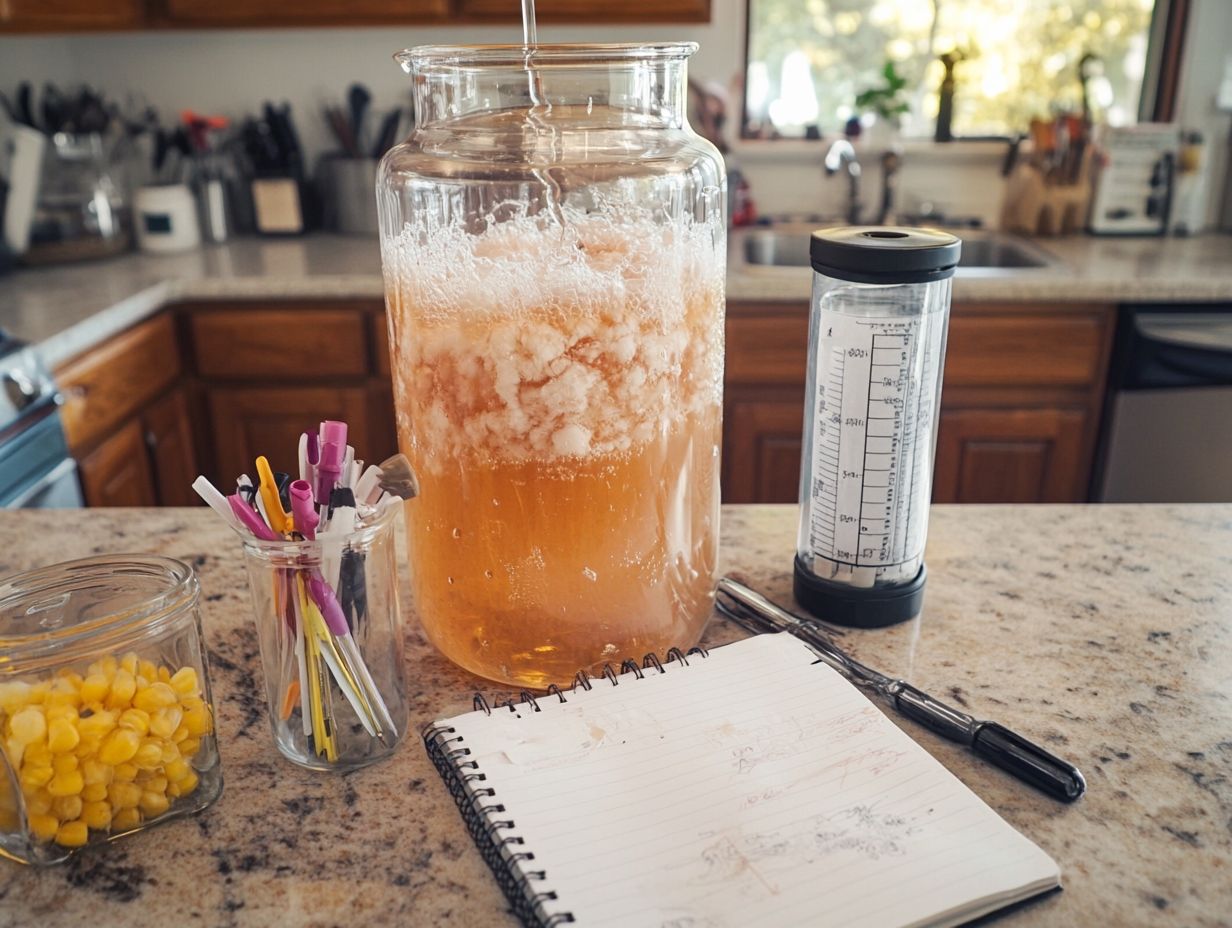
Understanding various types of fermentation is essential for anyone diving into lacto-fermentation. Each method, whether fermenting vegetables or crafting water kefir or Kombucha, offers distinctive benefits shaped by the dominant microorganisms at play, such as lactic acid bacteria.
Lactic acid fermentation stands out for its role in creating probiotic-rich foods like yogurt and sauerkraut. These aren t just tasty; they also work wonders for your gut health.
Alcoholic fermentation transforms sugars into alcohol and carbon dioxide, giving life to beverages like wine and beer. It plays a vital role in baking by helping bread rise to perfection.
Acetic acid fermentation is commonly encountered in vinegar production, adding a delightful tang that enhances culinary creations and acts as a natural preservative. Each fermentation type extends the shelf life of foods and enriches their nutritional profile, developing the complex flavors celebrated worldwide.
What Are the Key Factors for Successful Fermentation?
Successful fermentation relies on several essential factors, including the precise salt concentration, optimal fermentation temperature, and the careful selection of raw vegetables. This ensures that beneficial bacteria thrive while harmful bacteria are kept at bay.
Understanding the ideal salt concentration is critical; using too little can lead to spoilage, while too much may hinder the fermentation process. It’s equally important for you to monitor the fermentation temperature, as beneficial microorganisms tend to flourish within specific ranges, typically between 65 F and 75 F.
To create the best environment for fermentation, consider using a fermentation weight to keep your vegetables submerged, minimizing exposure to air that could invite unwanted flora. Selecting high-quality, fresh vegetables is vital; organic options generally contain fewer pesticides and deliver superior flavor.
By paying attention to these factors, you not only ensure successful fermentation but also enhance the quality and taste of your final product.
How Can Temperature and Humidity Affect Fermentation?
Temperature and humidity are critical factors that play a significant role in shaping the fermentation environment, directly influencing the activity of microorganisms and ultimately determining the success of your pickles or sauerkraut.
When temperatures climb too high, fermentation can take off like a rocket, resulting in off-flavors and unexpected outcomes. On the other hand, if temperatures drop too low, the process can slow down to a crawl, or even come to a complete halt. Ideally, you want to aim for a range between 65 F and 75 F, though this can fluctuate based on the specific microorganisms at play. Humidity also plays an essential role, either fostering or hindering the growth of beneficial bacteria. Some strains flourish in moist conditions, while others prefer a drier atmosphere.
To achieve the best results, it’s vital to keep a close watch on both temperature and humidity levels. Equip yourself with thermometers and hygrometers, and remember that even slight adjustments can lead to remarkable improvements in the quality of your fermented products.
What Are Some Tips for Preventing Mold Growth?
Preventing mold growth is paramount for successful fermentation, and by implementing effective strategies like managing salt concentration, ensuring adequate brine coverage, and maintaining a pristine fermentation environment you can safeguard your process and achieve remarkable results.
Controlling the fermentation temperature is crucial in inhibiting mold development. By maintaining a stable and appropriate temperature range, you encourage beneficial bacteria to flourish, effectively allowing them to outcompete any potential mold that might dare to intrude.
It’s essential for anyone engaged in fermentation to periodically check their brine levels and make adjustments as needed. Incorporating techniques such as stirring occasionally to redistribute salt and brine can be highly advantageous, keeping the environment inhospitable for mold.
By fostering a robust colony of beneficial bacteria, you create an ecosystem that naturally wards off unwanted molds, ensuring a successful fermentation experience.
How Can One Determine When Fermentation Is Complete?
Determining when fermentation is complete is a nuanced process that requires your keen observation of key signs. Look for bubbles, changes in texture, and conduct taste tests to assess the balance of flavors in your fermented garlic or sauerkraut.
Additional indicators to consider include the development of a tangy aroma and variations in color, which can add depth to your sensory experience. During fermentation, regularly checking for these visual cues, such as a foamy surface or the expansion of the product s volume, is essential.
Regarding taste testing, it s wise to start early. Sample small amounts over time to monitor the microbial evolution and flavors. The ideal time to store or indulge in these products typically emerges when they achieve a satisfying balance of acidity and texture, signaling readiness for either longer preservation or immediate enjoyment.
Frequently Asked Questions
What are some common problems that may occur during fermentation?
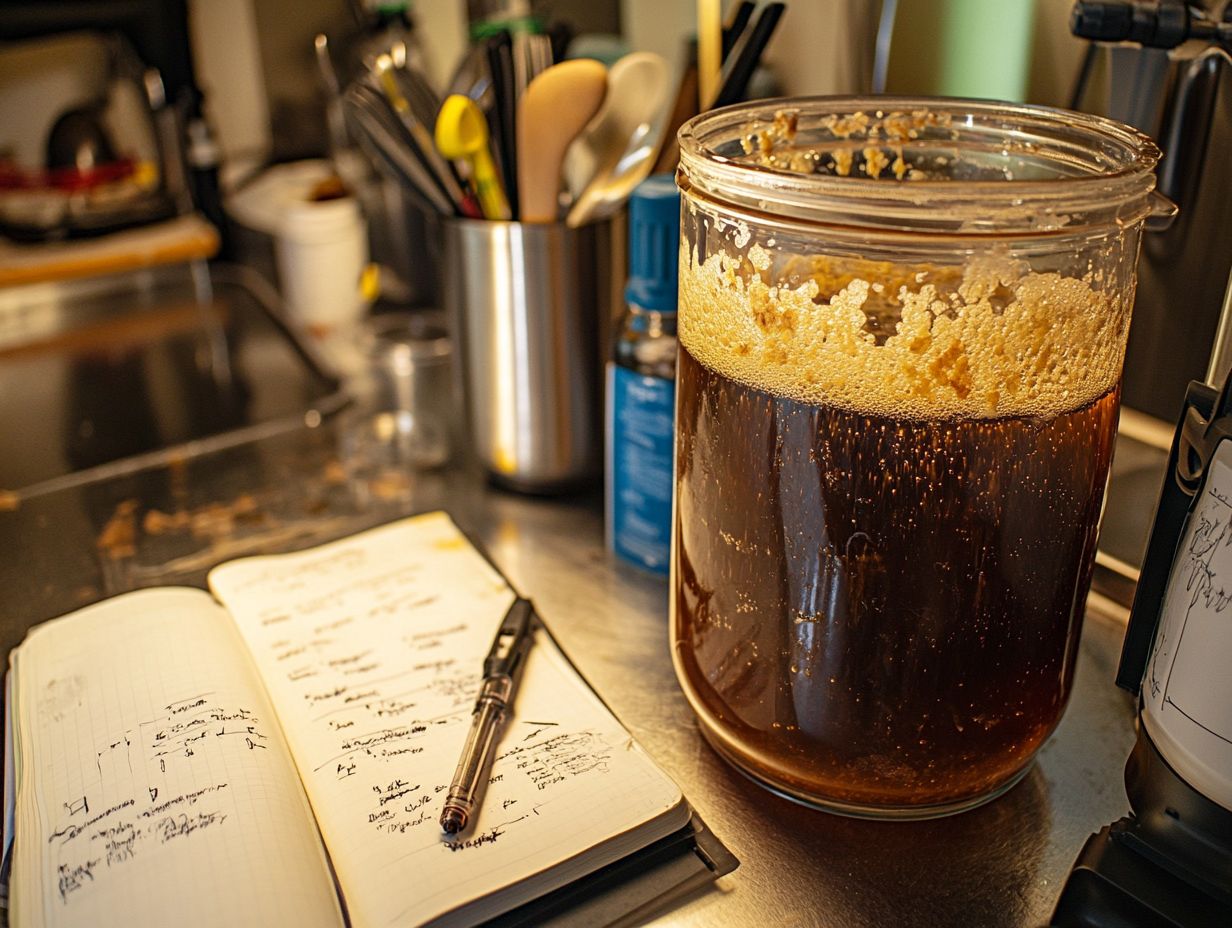
Fermentation is an exciting process, but it can sometimes go wrong! Some common problems that may occur during fermentation include stuck fermentation, off-flavors, contamination, brine disappearance, and the presence of harmful bacteria like E. coli.
What is stuck fermentation and how can it be resolved?
Stuck fermentation occurs when the yeast stops converting sugar into alcohol. This can be resolved by ensuring the yeast has enough nutrients and checking temperature and pH levels.
You may need to add more yeast if necessary. Check for low salt concentration and incorrect temperatures.
How can off-flavors be detected and prevented during fermentation?
Off-flavors in fermented beverages can be detected through taste and smell. Common odors include sulfur smell, vinegar smell, and putrefaction smell.
To prevent them from occurring, it is important to use quality ingredients, maintain proper sanitation, and monitor fermentation conditions closely. Beneficial bacteria like probiotics play a crucial role in achieving good fermentation outcomes.
What are the signs of contamination during fermentation?
Signs of contamination during fermentation include strange smells, mold growth, and changes in color or texture.
Other signs are the formation of Kahm yeast, a white film, and white particles. Cloudy brine and color change are also indicators of potential contamination.
How can contamination be avoided during fermentation?
To avoid contamination during fermentation, it is important to thoroughly clean and sanitize all equipment and use quality ingredients.
Monitor fermentation conditions carefully. Proper fermentation equipment and understanding food safety principles are essential to safe fermentation practices.
What should I do if my fermentation does not start?
If your fermentation does not start, check the temperature and pH levels to ensure they are within the proper range for the yeast.
You may need to add more yeast or nutrients to kickstart the fermentation process. Ensuring the presence of good bacteria and maintaining the right salt concentration can also help initiate the fermentation process.

